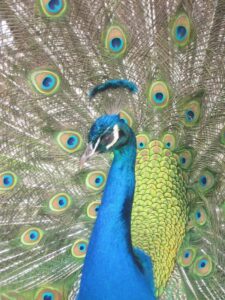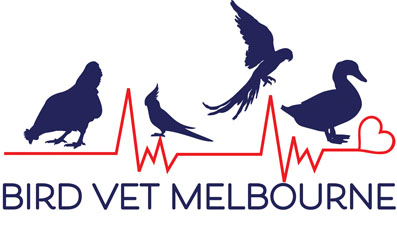Caring For Peacocks

Peacock and Peafowl Vet Services
The term ‘peahen’ refers to the female, ‘peacock’ to male and peafowl to either gender. Peafowl are indigenous to India, Burma, Java, Ceylon, Malaya and the Congo. In addition to the common Indian blue peafowl, Pavo cristatus, there are also three subspecies of the more flighty Java green peafowl: Pavo multicus.
Peafowl are members of the Galliformes (Chicken) family but they are more closely related to pheasants and turkeys than they are to domestic chickens. Peacocks are not recommended as pets in suburban areas as their loud call can be problematic with neighbours.
Diet and Husbandry for Peacocks
Peafowl will eat meat, grains and vegetables and are generally not finicky eaters. Protein and calcium levels in chicken rations designed for rapid growth or constant egg laying may be too high if fed as a sole diet for peafowl but they can be useful as part of the diet. Feeding a mix of good quality dried dog food, corn, grains, seeds, grass, greens, table scraps and some chicken rations is appropriate.
If kept confined, a shelter should be provided and pens should be covered as peacocks are strong flyers. Flights should be at least 3.5 metres wide and 2 metres high to accommodate the tail. Length is determined by the number of birds to be kept in the pen, with a minimum of 6 metres recommended for a trio of breeders (male and two hens).
Peacocks and People
The peacock is the national bird of India and peafowl have long been associated with royalty in that country, as well as in the Middle East and with the Pharaohs of Egypt. They were known to be transported by early Phoenician mariners. Aristole, c. 350 BC, wrote about the peafowl biology and the practice of fostering peafowl eggs under chickens. In Greek mythology Argos Pantoptes, the ‘one who sees all’, was a giant covered with hundreds of eyes who never slept as he only ever closed half of his eyes at any one time. When Juno, the immortal queen of the heavens, transferred Argos to the sky, his eyes were put into the tail of the peacock. The peacock was also considered sacred in by the early church in Europe
Peacocks were brought out to Australia by Europeans in the 1800s. In Victoria this was done by the Acclimatisation Society, a group dedicated to the deliberate release of wild birds, plants and animals thought to be aesthetically beautiful or of commercial benefit to humans. ‘Harewood’, a heritage property that one of our vets, Dr Pat Macwhirter owns, was one of the original sites where pheasant, guinea fowl and peacock were released under the auspices of the Acclimatisation Society. None of these species ever established feral populations as they did elsewhere in more tropical regions of Australia, but Pat’s peacock, Edward, who unfortunately died recently, lorded over the property for over 20 years, a favourite with friends and a very well loved companion.
While a mature peacock in prime condition can be mated to as many as five peahens, on a typical country property in southern Australia where peafowl range free as pets, because of the hens’ greater susceptibility to fox predation, males will usually outnumber females.
Evolution of the Peacock's Train
A peacock’s train originates from the back and consists of three types of highly derived covert feathers: the longest ones end in a fish tail structure, curved feathers are found at the edge of the train and ocellus-bearing (‘eye’) feathers vary considerably in length, so that ocelli appear scattered throughout the fanned train when the males display. Superficially such an elaborate train would seem to be a disadvantage in survival but, using the peacock as an example, Charles Darwin proposed that male ornament reveals information about age and vigour and that vigorous, older males have demonstrated their survival ability better than young males. Choosy females who select well ornamented males are likely to have better survivability in their offspring. Subsequent studies have shown that Darwin was right, offspring of peacocks with large trains had better survivability than those with smaller tails. Surprisingly, peacocks with large trains also showed greater ability to withstand fox predation than those with smaller trains.
Common Peacock Health Conditions
Worms and coccicidiosis Capillaria, intestinal round worms (Ascaridia) and caecal round worms (Heterakis gallinae) are all commonly diagnosed. Regular worming with levamisole, ivermectin or moxidectin is recommended. Coccidiosis is primarily a problem in juveniles housed with adults, which should be avoided. It is treated with toltrazuril (Baycox, Bayer) or amprolium (Coccivet, Vetafarm).
Histomoniasis (Blackhead). This potentially fatal disease is caused by an amoeba that is carried by the caecal round worm Heterakis. For further information see separate article
Respiratory tract infections with nasal discharge and swollen sinuses are occasionally seen in peafowl. As well as bacterial infections peafowl are susceptible to both Mycoplasma and to chlamydophilosis. Low vitamin A in the diet may damage respiratory epithelial cells and predispose to disease. In addition to identifying the underlying cause and treating appropriately, surgical lancing and drainage may be needed.
Devocalisation. Surgical devocalisation by chemically or surgically cauterising the syringeal membranes has been successfully carried out in peacocks. However, the technique carries an unacceptably high risks in otherwise well birds. We encourage re-homing rather than devocalisation and recommend quieter species of pet birds for suburban back gardens. Peacocks can be great bonded pets but they’re not for everyone, especially not in closely settled areas.
